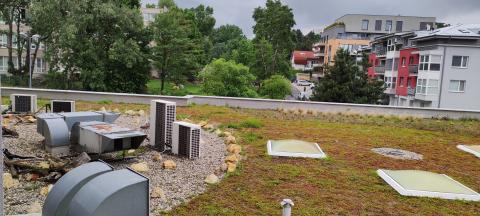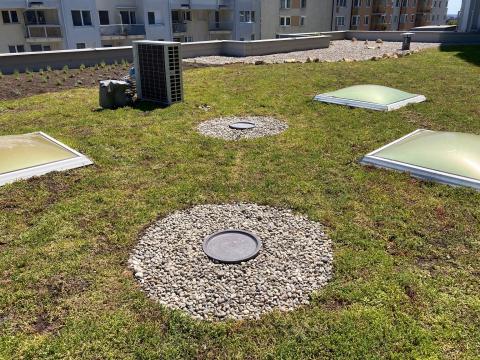Green roof on Municipality building promoting biodiversity

About this good practice
Climate change is an imminent concern and its impacts will only get worse, even if we successfully reduce carbon emissions – European cities will face more frequent droughts, heavy rainfall, flooding and heatwaves. Municipalities need to find a solution to those as well as tackling the loss of biodiversity in cities. Green roofs are effective both as an adaptation and mitigation practice in urban areas.
In 2021, an extensive green roof with an area of 585 m2 was built on the roof of the Municipality building of the Bratislava Karlova Ves. In addition to saving energy, the green roof has a significant impact on preventing the building from overheating during summer heat waves, as well as catching and slowing down rainwater runoff.
Additionally, the green roof was designed to support biodiversity. The diversity and variety are preserved, species are planted at different heights from spontaneus vegetation from the original graveled area. The newly created green roof also has small water elements used for birds to drink in times of drought, and different various types of dead wood, stones and other material that serve as refuge for insects and other invertebrates.
The green roof is visible from one part of the office building as well as from the adjacent upper floors of the residential building. The high aesthetical value is highly appreciated by the neighbours even if it is not open to the public for recreation purposes.
Expert opinion
This nice good practice from Bratislava is contributing to several policy goals of the European Union. By saving energy for heating and cooling with the help of a green roof that acts as insulation, it contributes to the decarbonisation of our buiding stock in line with the energy transition imperatives. By increasing green spaces and a deliberate design to attract insects and other species it responds to the targets of the EU's biodiversity strategy for 2030. Side effects are also the contribution to reducing the local temperature and thus the urban heat island syndrome, as well as a contribution to better rainwater management. The interesting aspect is the economic benefit from saving energy for heating and cooling which are a recurring annual cost to the building occupants. Comparing additional cost for installing the green roof and cost savings shows that the measure pays for itself in no time. This makes this good practice particularly interesting to any other public body wishing to reduce the environmental footprint of its building stock while increasing biodiversity. Easy to transfer!
Resources needed
The project is partly funded through subsidies from the OP Quality of the environment. Costs include: extensive vegetation roof: 32 000€ including the human resources In total the costs for the creation of the extensive green roof promoting biodiversity is approximately 53€ per square metre.
Evidence of success
The green roof plays a key role in saving energy for the building: from 1.8 kWh / m2 to 6.8 kWh / m2 for cooling and 6.44 kWh / m2 for heating (based on the available data).
Regarding biodiversity, the green roof is creating the patchwork of habitats which are varied due to the wide range of ground conditions – bare gravel substrate, mixture of vegetation with different density and height. This is increasing the biodiversity of this urban area.
Potential for learning or transfer
The practice is easily transferable and can be transfered with adequate resources and an engagement, it is a practice that is becoming increasingly popular. To include ensure that the green roof is effective to tackle climate change and meets the biodiversity needs of the local area. It needs to foster biodiversity by using a variety of habitats, vegetation and plant species that attract bees, butterflies and other insects and pollinators by adding dead woods and other elements. These elements do not generallty require additional financial costs and will be very beneficial for biodiversity
Further information
Images


